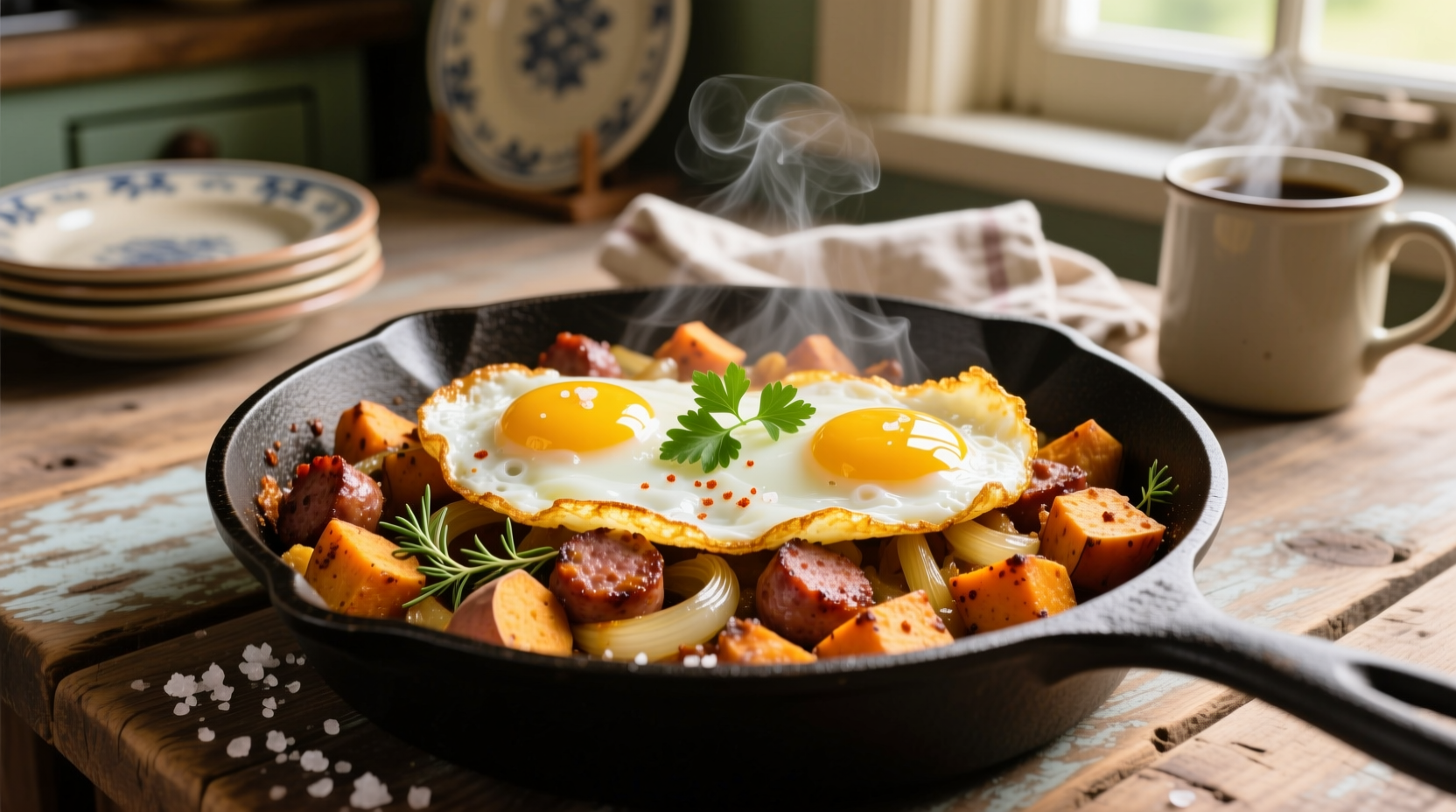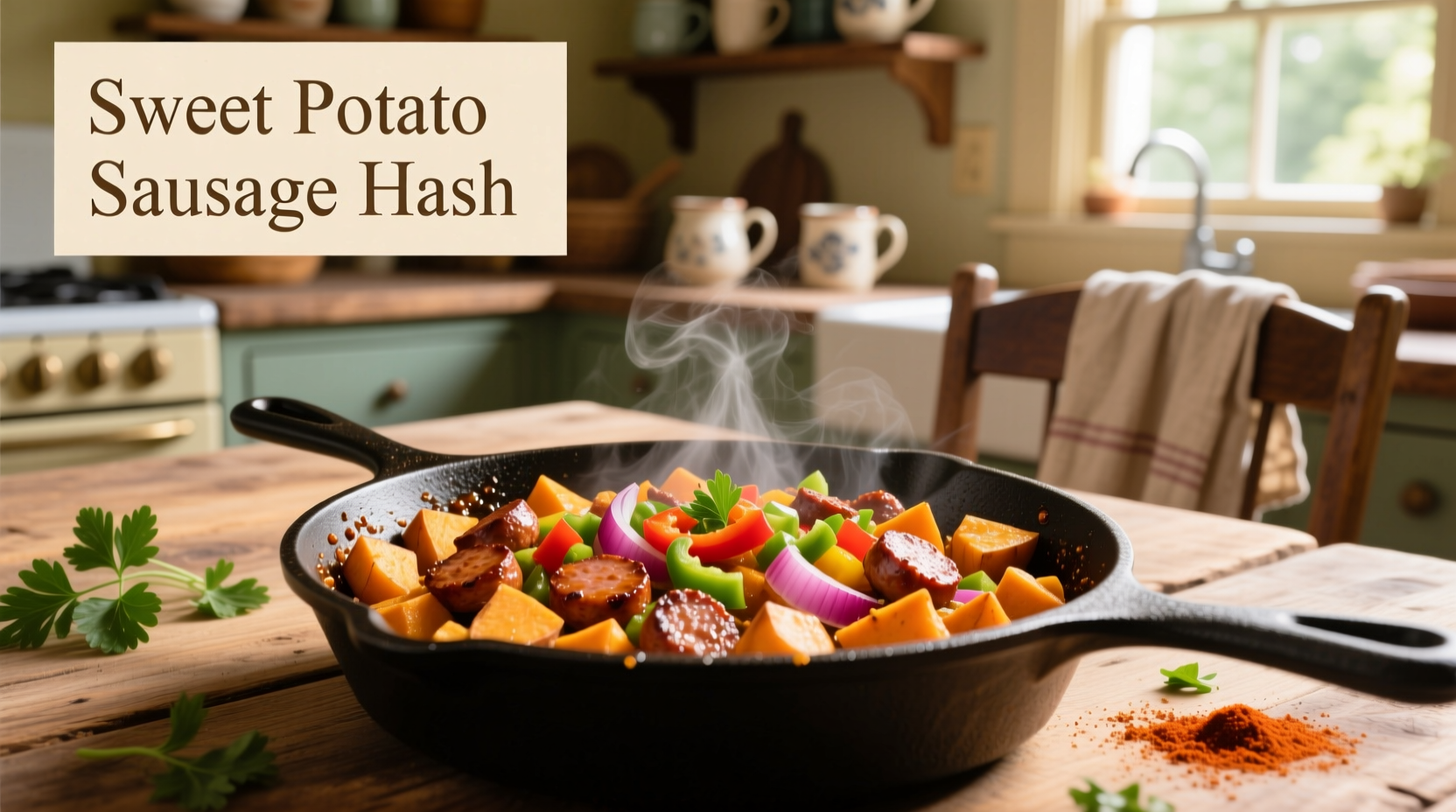Perfect sweet potato sausage hash delivers crispy sweet potatoes, savory sausage, and aromatic herbs in a single-pan breakfast that's ready in 30 minutes. This nutrient-dense meal provides 22g protein, 35g complex carbohydrates, and essential vitamins A and C per serving, making it ideal for hearty breakfasts or brunch gatherings.
Creating exceptional sweet potato sausage hash requires understanding the balance between crispy texture and tender ingredients. Unlike traditional potato hash, sweet potatoes contain more natural sugars that caramelize beautifully but require careful temperature control to prevent burning. Professional chefs consistently achieve perfect results by following three critical techniques: properly par-cooking sweet potatoes, selecting the right sausage variety, and managing pan temperature throughout cooking.
Why This Hash Recipe Works Every Time
Sweet potato sausage hash has become a breakfast staple for good reason. The natural sweetness of roasted sweet potatoes complements the savory richness of quality sausage, while the addition of aromatic vegetables creates a flavor profile that satisfies without being overly heavy. Food scientists confirm that the Maillard reaction—the chemical process that creates browning and complex flavors—occurs optimally between 285-325°F, which explains why medium heat produces superior results compared to high-heat cooking that often leads to burnt exteriors and raw interiors.
| Sweet Potato Variety | Texture Result | Best Cooking Method | Sweetness Level |
|---|---|---|---|
| Beauregard | Firm, holds shape | Par-boil 5 minutes | ★★★★☆ |
| Jewel | Moist, slightly creamy | Par-boil 3 minutes | ★★★★★ |
| Japanese | Dry, fluffy texture | Par-boil 7 minutes | ★★★☆☆ |
| Garnet | Starchy, holds shape | Par-boil 4 minutes | ★★★☆☆ |
Essential Ingredients for Perfect Hash
The foundation of exceptional sweet potato sausage hash begins with ingredient selection. While many recipes treat sweet potatoes as interchangeable, agricultural research from the USDA shows significant nutritional and textural differences between varieties. For hash, Jewel or Beauregard sweet potatoes provide the ideal balance of moisture content and starch that yields crispy edges without becoming mushy.
When selecting sausage, consider these options based on your flavor preferences:
- Breakfast sausage (pork or turkey) - Traditional choice with sage and black pepper notes
- Andouille sausage - Adds Cajun spice complexity (use 25% less salt in recipe)
- Chorizo - Provides smoky depth (remove casing before cooking)
- Plant-based sausage - Modern alternative (add 1 tsp smoked paprika for depth)
Step-by-Step Cooking Process
Follow this professional technique for restaurant-quality results at home:
- Prep sweet potatoes: Peel and cut into ½-inch cubes. Par-boil for 4-5 minutes until slightly tender but still firm. Drain thoroughly and pat completely dry.
- Cook sausage: Heat cast-iron skillet over medium heat. Add sausage, breaking into small pieces. Cook until browned but not fully crisp (about 6-8 minutes). Remove sausage, leaving 1 tbsp fat in pan.
- Crisp sweet potatoes: Increase heat to medium-high. Add sweet potatoes in single layer. Cook undisturbed for 4 minutes to develop crust. Stir and continue cooking 8-10 minutes until golden and tender.
- Combine ingredients: Return sausage to pan with onions, bell peppers, and garlic. Cook 3-4 minutes until vegetables soften.
- Finish and serve: Season with smoked paprika, salt, and pepper. Create wells in hash and crack eggs into them if desired. Cover and cook 3-4 minutes for runny yolks.

Proven Cooking Techniques for Success
Avoid common mistakes that ruin hash with these chef-tested methods:
- Dry ingredients thoroughly: Moisture is the enemy of crispiness. After par-boiling, spread sweet potatoes on paper towels and let air-dry 10 minutes.
- Don't overcrowd the pan: Cook in batches if necessary. Overcrowding lowers pan temperature and creates steam instead of sear.
- Resist stirring too soon: Allow 3-4 minutes of undisturbed cooking time to develop proper crust before stirring.
- Finish with acid: A splash of apple cider vinegar (1 tsp per serving) brightens flavors and balances richness.
When This Dish Works Best
Sweet potato sausage hash shines in specific contexts while having limitations in others. Understanding these boundaries ensures perfect results:
- Ideal for: Weekend brunches, post-workout meals, cold-weather breakfasts, and meal prep (stores well for 3-4 days)
- Not recommended: As a light lunch option (too hearty), for strict paleo diets (unless using compliant sausage), or when time is extremely limited (requires 25-30 minutes)
- Special occasions: Holiday breakfasts, camping trips (cooks well over campfire), and potluck gatherings
- Dietary adaptations: Gluten-free naturally, keto-friendly with reduced sweet potato ratio, and easily made dairy-free
Storage and Reheating Guidelines
Proper storage maintains texture and ensures food safety. According to USDA food safety guidelines, cooked hash should be refrigerated within two hours of preparation and consumed within 3-4 days. For best results when reheating:
- Skillet method: Heat 1 tsp oil in cast-iron skillet over medium heat. Add hash in single layer and cook undisturbed 3-4 minutes until crispy
- Oven method: Spread on baking sheet at 375°F for 10-12 minutes for even reheating
- Avoid microwave: Creates uneven texture and sogginess (unless absolutely necessary—then use 50% power)
Popular Variations for Dietary Needs
Adapt this versatile recipe to accommodate various dietary requirements without sacrificing flavor:
- Keto version: Reduce sweet potato ratio by 50%, increase sausage by 25%, add ½ avocado per serving
- Vegan option: Use plant-based sausage, add 1 cup black beans, and include smoked paprika for depth
- Lower-carb alternative: Substitute half sweet potatoes with diced cauliflower
- Spicy upgrade: Add 1 diced jalapeño with onions and ¼ tsp cayenne pepper
Troubleshooting Common Issues
Resolve these frequent problems with targeted solutions:
- Soggy hash: Sweet potatoes weren't dried thoroughly or pan wasn't hot enough. Solution: Par-boil less, dry longer, and ensure proper pan temperature.
- Burnt exterior, raw interior: Heat too high. Solution: Cook over medium heat and cover pan for last 5 minutes to steam interior.
- Excessive sticking: Pan not properly preheated or insufficient fat. Solution: Heat pan 2 minutes before adding oil, then wait 30 seconds before adding ingredients.
- Bland flavor: Underseasoned. Solution: Season in layers—salt sweet potatoes while par-boiling, season sausage while cooking, and finish with herbs.
Frequently Asked Questions
Can I make sweet potato sausage hash ahead of time?
Yes, prepare components separately: cook sausage and store separately from par-boiled sweet potatoes. Combine and finish cooking when ready to serve for optimal texture. Fully assembled hash reheats well but won't be as crispy as freshly made.
What's the best pan for making hash?
A well-seasoned cast-iron skillet provides superior heat retention for perfect browning. Carbon steel works almost as well. Avoid non-stick pans as they don't get hot enough for proper caramelization. Ensure your pan is at least 12 inches for proper ingredient distribution.
How do I prevent sweet potatoes from burning?
Par-boil sweet potatoes first to reduce cooking time in the pan. Maintain medium heat (not medium-high), and stir only when necessary to allow proper browning. If edges start browning too quickly, reduce heat slightly and cover pan for 1-2 minutes to finish cooking through.
Can I freeze sweet potato sausage hash?
Yes, cool completely and freeze in airtight containers for up to 3 months. Thaw overnight in refrigerator before reheating. For best results, freeze components separately and combine when reheating to maintain texture integrity.











 浙公网安备
33010002000092号
浙公网安备
33010002000092号 浙B2-20120091-4
浙B2-20120091-4